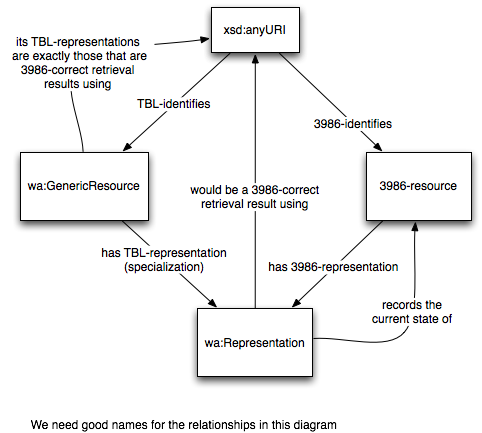- From: Jonathan Rees <jar@creativecommons.org>
- Date: Tue, 27 Sep 2011 12:01:51 -0400
- To: AWWSW TF <public-awwsw@w3.org>
- Message-ID: <CACHXnapQ2KxCkerwLdxcoy=5m9XOaJShgW5iuTgCacofFWxMMQ@mail.gmail.com>
Mulling over designs for httpRange-14(a) opt-in, I made a picture (attached), just for fun, that superimposes the Fielding/3986 architecture with the TimBL architecture. What stands out is the common ground: There is general agreement on what constitutes a correct retrieval operation using a URI. The agreement derives from the RFCs and from server and client behavior. This is invariant as we modulate theories of what the resource is and what "is a representation of" means. In the Fielding architecture the resource is unconstrained. I can give you a bunch of different resources, and then when you challenge me to prove that there is a resource with those Fielding-representations, I can cook up any story I like, post hoc, and you'd have no way to prove me wrong. In Tim's architecture the resource is determined, modulo usually we probably don't care about, by what the correct retrieval results would be. Once those results are determined, there's no choice as to what the resource is. Contrariwise, if the server side commits to what the resource is, we can hold them to it by checking any TBL-representations that they deliver. httpRange-14(a) opt-in would be a statement or protocol element that says that the URI Fielding-identifies the generic resource (i.e. the same thing that it TBL-identifies). Nothing much new here, pretty much what Pat has said in different words (although I put less stock in "access" and more in social agreement over what would constitute correct access were it to occur). Just noodling. Jonathan
Attachments
- image/png attachment: gr.png

Received on Tuesday, 27 September 2011 16:02:32 UTC